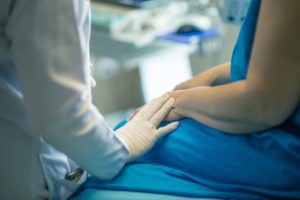Endometriosis Therapy for Infertility
If endometriosis is diagnosed, the question of the connection between endometriosis and the desire to have children usually arises. Endometriosis can affect fertility on many levels and often, but not always, makes conception difficult.
The therapy of endometriosis is individually tailored to the primary goal of the therapy. This means that if pain is the predominant symptom, different priorities are set for the therapy than if an unfulfilled desire to have children is the biggest problem. Of course, both can be present at the same time.
If the patient wants to become pregnant as soon as possible, or within the next 6 months, the influence of each potential therapy on pregnancy and a possible fertility therapy must be considered.
In advance: endometriosis does not automatically mean infertility

Not always does the stork bring the baby immediately.
Not every woman who suffers from endometriosis is therefore infertile. Studies are not entirely clear, but it can be assumed that about 30-50% of all affected women have fertility problems or an unfulfilled desire to have children. [1] Endometriosis and pregnancy are therefore not mutually exclusive, but endometriosis is often associated with difficult conception. However, even with confirmed endometriosis and an unfulfilled desire to have children, further investigation should always be carried out, as there are other factors that lead to an unfulfilled desire to have children.
Therefore, in the case of an unfulfilled desire to have a child, all other causes should always be investigated in both partners.
Endometriosis and the desire to have children: choosing the right therapy
If there is a desire to have children with endometriosis, this should definitely be taken into account with regard to the possible therapy.If the desire to have children is not too far in the future, hormone therapy is not an option, as the hormones of hormonal therapy have a contraceptive effect and do not remove the endometriosis. If possible, endometriosis lesions should be surgically removed in women of childbearing potential (excision). [4] But here, too, different goals are set for the operation than without the desire to have children. Multiple surgeries should be avoided, if possible, if you want to have children. Infertility treatment is often useful. Multimodal pain management should also be incorporated when pain is present.
When does surgery make sense for endometriosis and the desire to have children?

Surgery can promote fertility in endometriosis
Surgery for endometriosis, especially if it is the first surgery for endometriosis, can have a strong positive impact on fertility. For example, adhesions or cysts that interfere with pregnancy can be removed. By removing endometriosis cysts and as many endometriosis lesions as possible, the above mechanisms can be reduced or completely removed in one fell swoop.
However, if there are deep infiltrating endometriosis lesions with bowel involvement or other factors that would entail an abdominal incision, a temporary artificial bowel outlet, or a risky and extensive surgery with a long recovery period, full surgery is often avoided for the time being. Frequently, partial surgery is then performed and followed by fertility treatment. Full reconstruction is then postponed until after completion of the childbearing treatment. However, this is an individual decision.
However, if the desire to have a child is still years in the future, the focus is naturally on complete removal and symptom control.
The decision to operate is always an individual decision, which should be discussed together with a specialized doctor after a detailed examination.
What type of surgery is suitable?
The type and manner of surgery, for example when removing endometriosis cysts from the ovary, also has an influence on a woman’s fertility. Since the operation itself can also have a negative effect on the ovary due to mechanical irritation and tissue damage, the ovary is spared as much as possible during surgical treatment of endometriosis and an existing desire to have children. [4] That is, it is more likely to risk leaving small foci behind if too much ovarian tissue would otherwise have to be removed. This is because the greater the manipulation during surgery, the worse the hormonal situation in the ovary afterwards and the fewer eggs mature from the ovary. This must also be taken into account in the treatment of endometriosis and the desire to have children.
As mentioned above, if possible, an abdominal incision or artificial anus is avoided. Follow-up surgeries (such as the reversal of the artificial intestinal outlet) or long healing periods delay the start of the fertility therapy / pregnancy and must therefore always be weighed individually.
Additional surgical measures in case of desire to have children:

In each case, the type of surgery is an individual decision that depends on many factors.
An abdominal endoscopy for the diagnosis and removal of endometriosis is a useful operation in cases of unfulfilled desire for a child. As a rule, a uterus endoscopy and a fallopian tube patency test are also performed here. For this purpose, the uterine cavity is viewed with a camera in order to exclude possible anatomical obstacles to implantation. Smaller polyps or uterine septa can be removed during the same operation.
Blue dye is flushed through the uterus into the fallopian tubes to check for tubal patency. The leakage of this blue fluid from the fallopian tubes can then normally be seen through the camera of the laparoscopy.
Thus, in one operation, various reasons for unfulfilled desire to have children can be clarified and, if necessary, already remedied.
How long do you have to wait to get pregnant after surgery?
If it were only about endometriosis, the optimal time after surgery to get pregnant would certainly be immediately.
However, after a laparoscopy, you should not exert yourself heavily (sports, heavy lifting, etc.) for 4-6 weeks. After a uterus endoscopy, which is often performed if you wish to have children, you should refrain from sexual intercourse for 4 weeks in order to avoid infections.
Thus, after the standard operation for endometriosis and desire for a child – laparoscopy with tubal patency test and uterus endoscopy – the first attempt can be started after 4 weeks.

Depending on the type of surgery, you should wait up to three months before becoming pregnant.
For an abdominal incision, the average recommendation is three months after the abdominal incision not to get pregnant. However, this may be less or more, depending on the size of the incision, the surgery, etc. The background of this regulation is the stretching of the abdomen during pregnancy. In order to withstand this strain the abdominal incision should be healed in all layers.
A special case is the removal of endometriosis lesions in the uterine wall or fibroids during surgery. Here, the time should always be discussed individually with the surgeon.
Endometriosis and the desire to have children should therefore always be discussed individually with the gynecologist, not only with regard to the therapy of the disease. If surgery is required, laparoscopy is preferable to an abdominal incision in the case of endometriosis and the desire to have children, but this is not always possible.
Summary
Endometriosis and the desire to have children are not in principle mutually exclusive, but the risk of infertility is higher and complications during pregnancy occur more often.

Infertility can be resolved with the right individual treatment.
Operations that remove endometriosis cysts or adhesions, for example, can promote fertility. Other diagnostic and therapeutic measures can usually be performed at the same time as the laparoscopy. When possible, surgery is performed via laparoscopy to avoid long healing periods.
However, the methods used must be decided individually with the attending physician. Even after successful surgery, infertility treatment may be the only way to achieve pregnancy.
Often, in the case of an unfulfilled desire to have children, a uterus endoscopy and fallopian tube patency test are performed in addition to the laparoscopy in order to clarify other causes. After this type of surgery, one should usually wait 4 weeks before attempting pregnancy. A longer waiting period is usually necessary for abdominal incisions or uterine wall surgeries.
In addition, complications can arise during pregnancy due to endometriosis. Therefore, the scheduled appointments with the gynecologist and midwife should be kept at all costs. You can find more information about this here.
Nevertheless, endometriosis and the desire to have children are not mutually exclusive and an uncomplicated pregnancy may also be possible.
References
- Current Research on Endometriosis: An Interview with Deborah Bush - 6. February 2024
- Pain and Pain Management – Interview with Rehab Psychologist Teresa - 19. November 2023
- Physiotherapy for Endometriosis – Interview with Annika Cost – with Exercises - 19. November 2023
